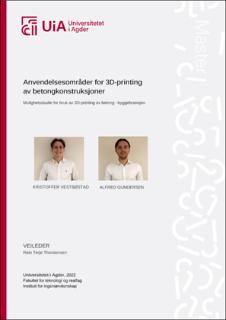| dc.description.abstract | The intention of this master thesis is to investigate the application area for 3D printing of concrete in
the construction industry and was written during the spring of 2022 at the University of Agder. 3D
printing or "additive manufacturing" is a process that combines materials in liquid- or powder-form,
where a printer produces the digital 3D model. Productivity in today's construction industry does not
satisfy society's growing need for rapid completion of today's new buildings, and projects exceeding
in time and cost is not uncommon. Through this work, the authors will investigate challenges and
possibilities of various projects such as large-scale 3D printed concrete constructions on-site, as well
as 3D printing of pre-produced concrete elements on-site or in the vicinity of the construction sites.
The study will explore the methods for 3D-printing of concrete, associated design possibilities and
the technology's economic and environmental aspects. The report is mainly based on a literature
study, but qualitative interviews were also conducted for better insight into how 3D printing of
concrete is used in the current construction industry and what the future potential is. The results
indicated that 3D printing of concrete can streamline the construction industry through automation
of manual work processes and reduce total construction time and labor compared to conventional
construction methods. 3D printing of concrete strengthens the interaction with the
BuildingInformationModeling (BIM) platform. It also turns out that printing large-scale concrete
structures will reduce cold bridges. The area of application will depend on the type of construction,
project characteristics, geographical location and the weather and climate environment. The use of
3D printing in the construction industry will provide greater freedom in the design and building of
more geometrically complex constructions, as the printer is unaffected by the level of complexity of
the design. The use of topology-optimized constructions will also create opportunities for slimmer
and lighter constructions, as well as new economic and environmental savings compared to
conventional construction methods. The technology also places different demands on concrete
technology than that of conventional casting of concrete, and today's 3D printers mainly print
smaller constructions up to a maximum of three floors. On the same note, this will also create
substantial challenges regarding the design phase, standardization and implementation. | |
